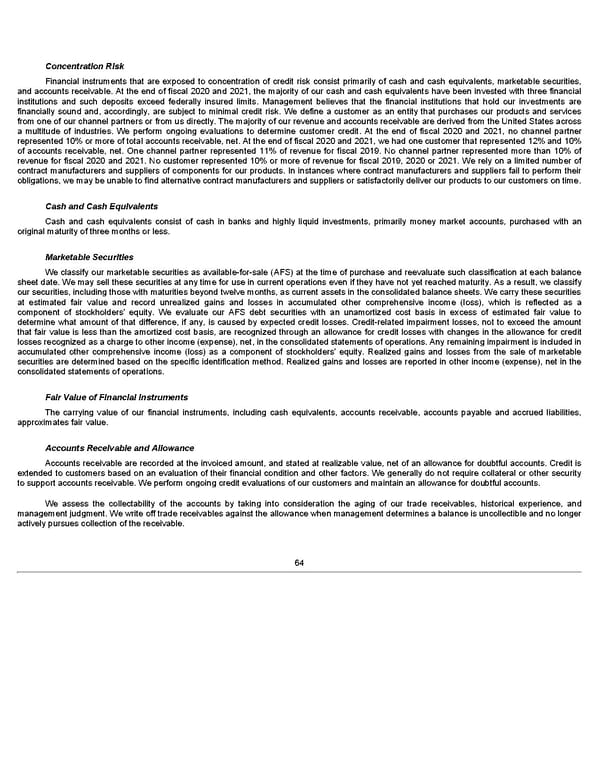Concentration Risk Financial instruments that are exposed to concentration of credit risk consist primarily of cash and cash equivalents, marketable securities, and accounts receivable. At the end of fiscal 2020 and 2021, the majority of our cash and cash equivalents have been invested with three financial institutions and such deposits exceed federally insured limits. Management believes that the financial institutions that hold our investments are financially sound and, accordingly, are subject to minimal credit risk. We define a customer as an entity that purchases our products and services from one of our channel partners or from us directly. The majority of our revenue and accounts receivable are derived from the United States across a multitude of industries. We perform ongoing evaluations to determine customer credit. At the end of fiscal 2020 and 2021, no channel partner represented 10% or more of total accounts receivable, net. At the end of fiscal 2020 and 2021, we had one customer that represented 12% and 10% of accounts receivable, net. One channel partner represented 11% of revenue for fiscal 2019. No channel partner represented more than 10% of revenue for fiscal 2020 and 2021. No customer represented 10% or more of revenue for fiscal 2019, 2020 or 2021. We rely on a limited number of contract manufacturers and suppliers of components for our products. In instances where contract manufacturers and suppliers fail to perform their obligations, we may be unable to find alternative contract manufacturers and suppliers or satisfactorily deliver our products to our customers on time. Cash and Cash Equivalents Cash and cash equivalents consist of cash in banks and highly liquid investments, primarily money market accounts, purchased with an original maturity of three months or less. Marketable Securities We classify our marketable securities as available-for-sale (AFS) at the time of purchase and reevaluate such classification at each balance sheet date. We may sell these securities at any time for use in current operations even if they have not yet reached maturity. As a result, we classify our securities, including those with maturities beyond twelve months, as current assets in the consolidated balance sheets. We carry these securities at estimated fair value and record unrealized gains and losses in accumulated other comprehensive income (loss), which is reflected as a component of stockholders' equity. We evaluate our AFS debt securities with an unamortized cost basis in excess of estimated fair value to determine what amount of that difference, if any, is caused by expected credit losses. Credit-related impairment losses, not to exceed the amount that fair value is less than the amortized cost basis, are recognized through an allowance for credit losses with changes in the allowance for credit losses recognized as a charge to other income (expense), net, in the consolidated statements of operations. Any remaining impairment is included in accumulated other comprehensive income (loss) as a component of stockholders' equity. Realized gains and losses from the sale of marketable securities are determined based on the specific identification method. Realized gains and losses are reported in other income (expense), net in the consolidated statements of operations. Fair Value of Financial Instruments The carrying value of our financial instruments, including cash equivalents, accounts receivable, accounts payable and accrued liabilities, approximates fair value. Accounts Receivable and Allowance Accounts receivable are recorded at the invoiced amount, and stated at realizable value, net of an allowance for doubtful accounts. Credit is extended to customers based on an evaluation of their financial condition and other factors. We generally do not require collateral or other security to support accounts receivable. We perform ongoing credit evaluations of our customers and maintain an allowance for doubtful accounts. We assess the collectability of the accounts by taking into consideration the aging of our trade receivables, historical experience, and management judgment. We write off trade receivables against the allowance when management determines a balance is uncollectible and no longer actively pursues collection of the receivable. 64
 Annua lReport Page 63 Page 65
Annua lReport Page 63 Page 65